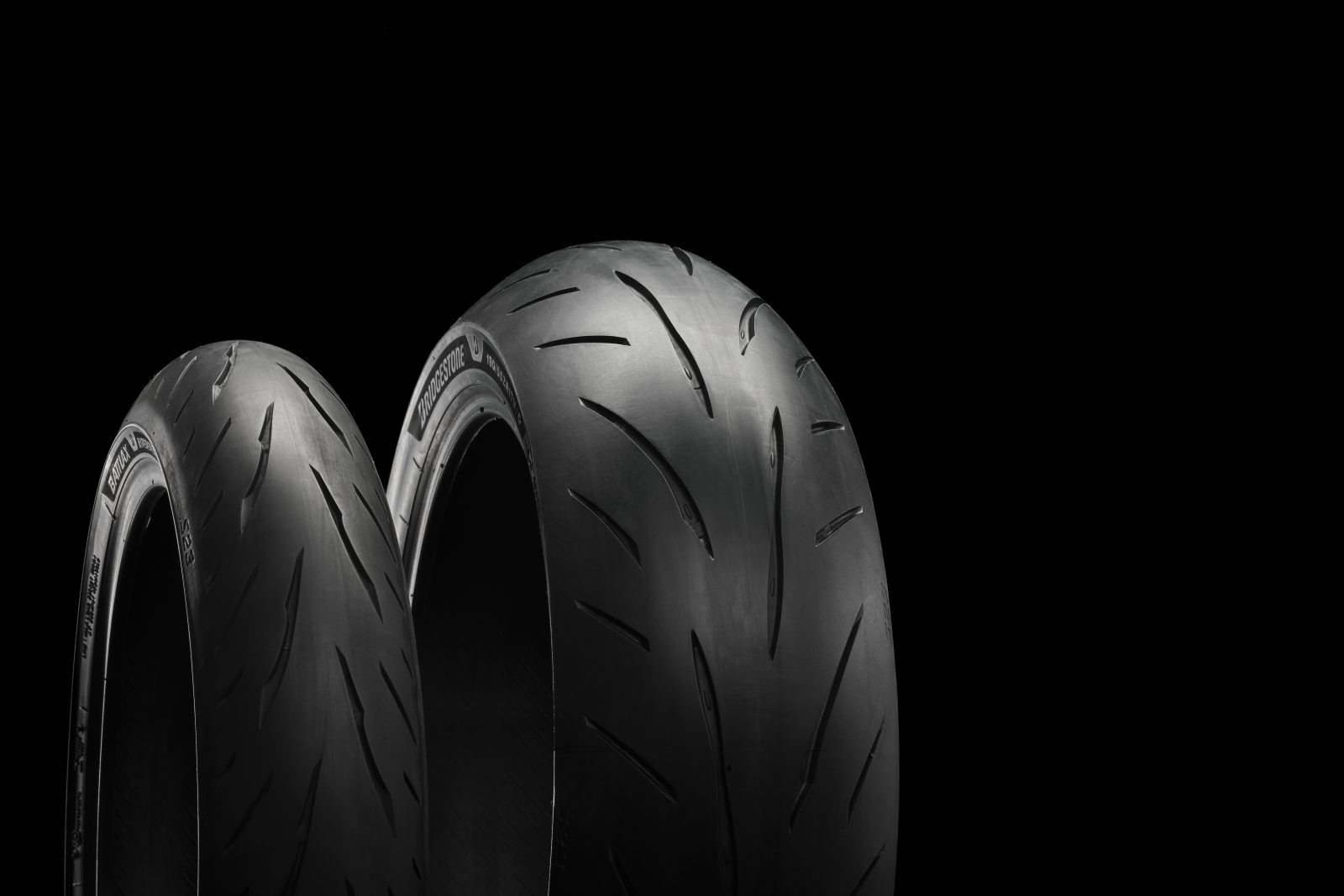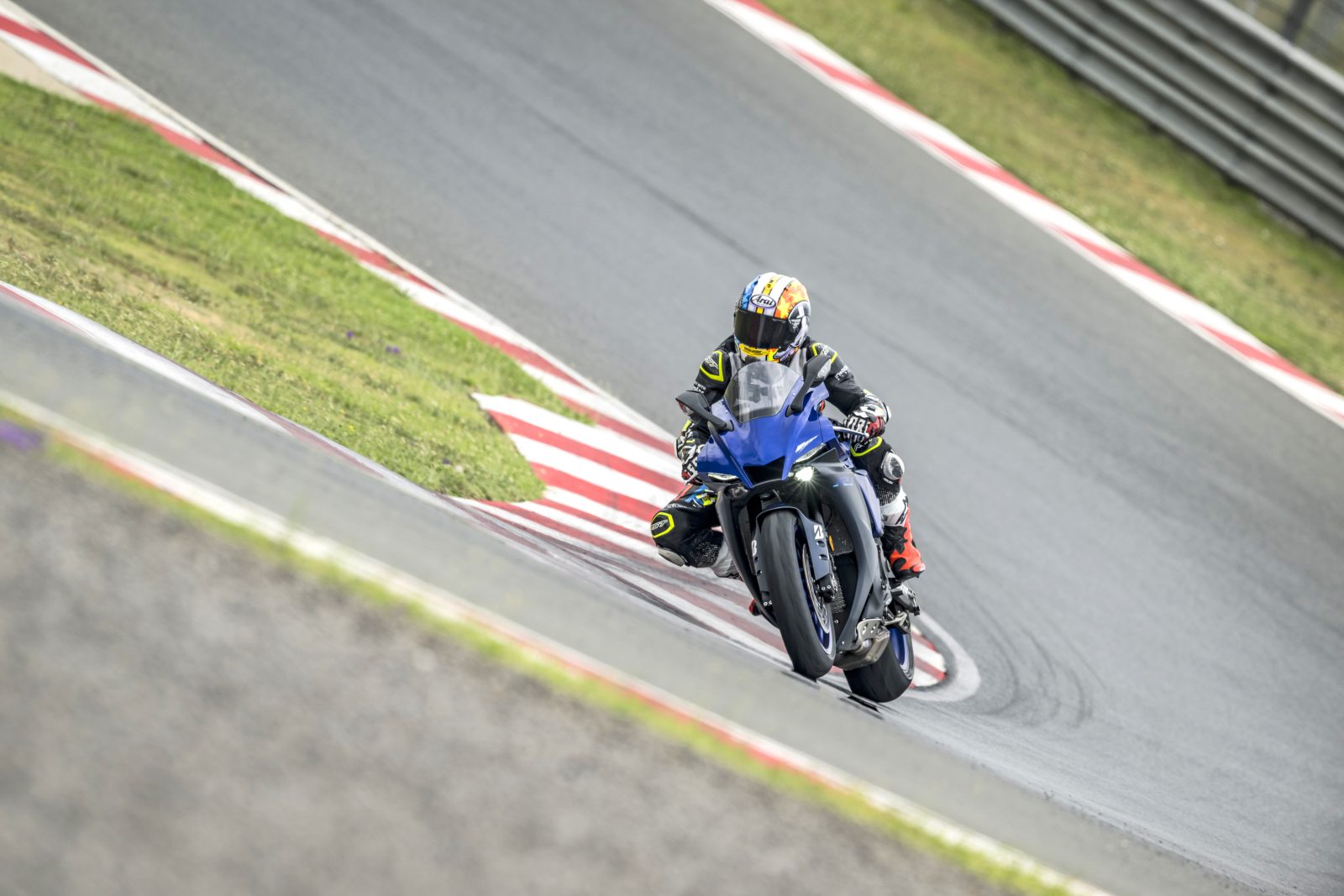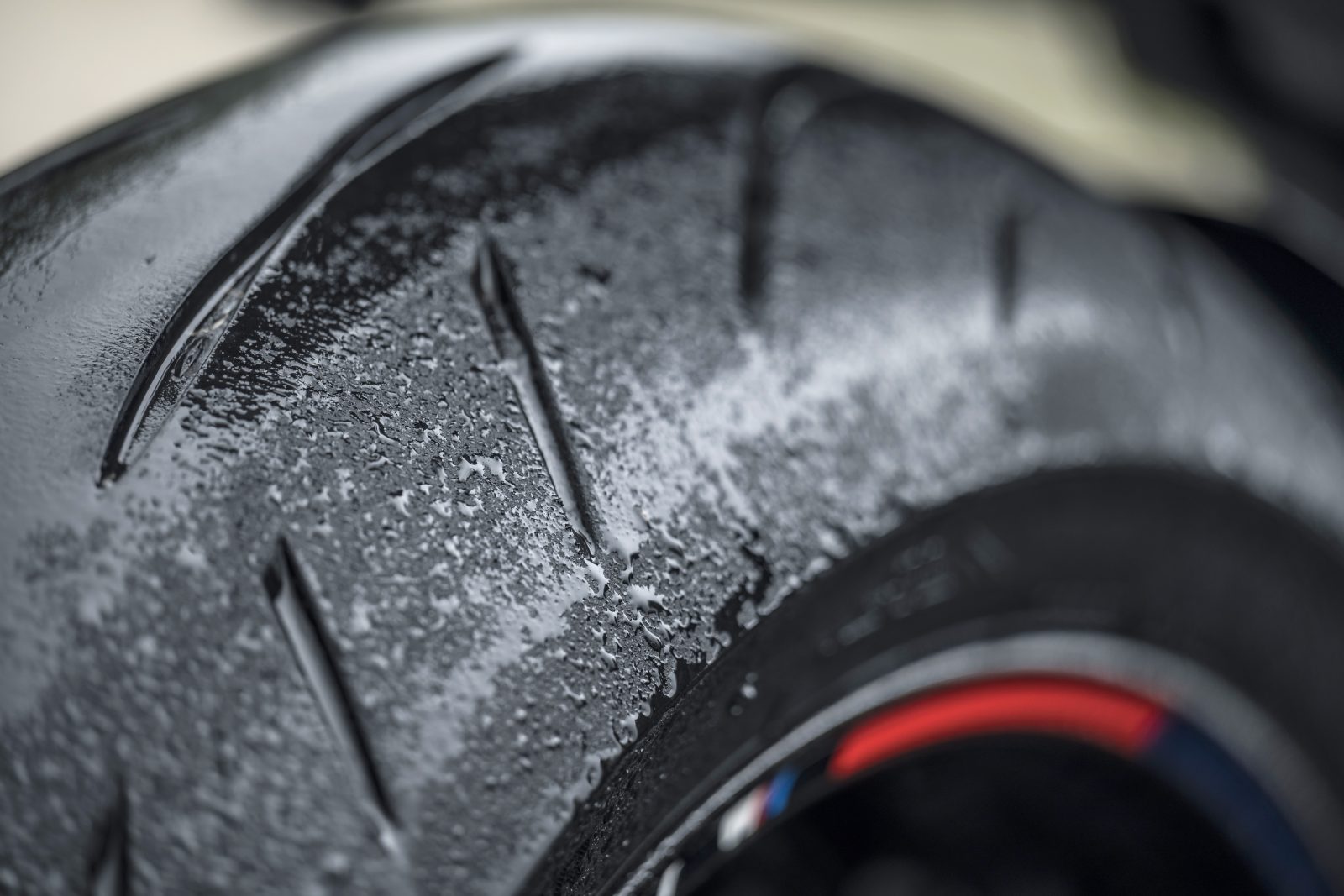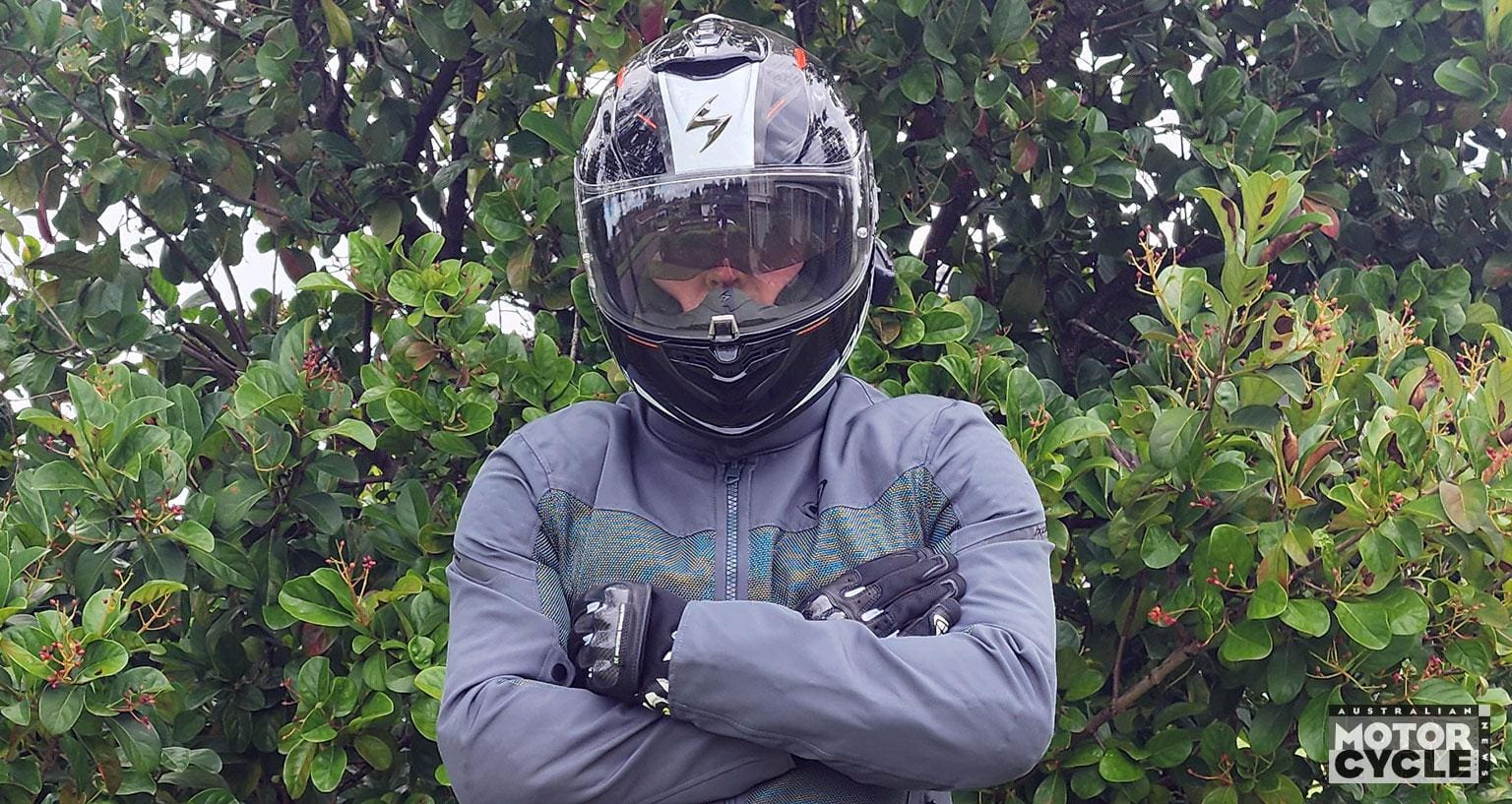The all-new Bridgestone Battlax Hypersport S23 builds on the tyre manufacturer’s acclaimed all-round sportsbike tyre, the S22. The S23 is designed to excel on both road and track, and in all conditions. Although we tested the new S23 on the sun-kissed Kyalami race track in South Africa, Bridgestone makes the bold claim that it will be equally at home on the wet roads in Oz.
That’s not all. In dry conditions it’s claiming a five percent increase in corner speed and a reduction in lap times by 2.4 percent (on average during testing) over its predecessor. And in wet conditions, it’s claiming a seven percent drainage resistance, three percent shorter braking distances and lap times reduced by as much as four percent. All this and a claimed eight percent increase in mileage.

ON TRACK
This was a track-only test held in warm conditions of around 19-20℃ with a rain shower thrown in for good measure, as if Bridgestone had ordered it especially. We didn’t use tyre warmers but the bikes were parked in pitlane in the sun and pressures were set to 33psi front and rear.
Leaving pitlane, it was immediately apparent the new S23 works from the get-go. Within a few corners I felt comfortable enough to touch my knee down, and in less than a full lap was up to pace. In fact, by the end of lap one I had settled into a comfortably fast trackday rhythm.
Both feel and feedback were excellent, especially from the front. On the first lap, I wasn’t guessing where the grip was but feeling it. And this was on the MT-09, a highly accomplished all-round roadbike, but certainly no race machine complete with a high-end performance fork.

On the MT-09, and later the XSR900 and KTM’s Duke 890 R, I was pushing hard, trying to reach the limits of the S23 rubber. The rear tyre coped without any issues and the front continued to give confidence-inspiring feedback. Ground clearance on both Yamahas, and a lack of control from the MT-09’s rear shock, were the limiting factors, not the performance of the rubber.
When the MT’s rear shock started to give up the fight, I could feel the rear tyre working, doing the work of the suspension, its tenacious new edge grip coming to the fore.
KTM’s 890 R proved almost the perfect tool for the track and tyres, its gutsy, linear power delivery and unequalled agility enabled me to push the boundaries in safety while seriously attacking Kyalami’s apexes and carrying dizzying corner speed. Some of the corners at Kyalami are taken at 180km/h with your knee pushed into the deck. That is a lot to ask from a road-legal tyre but I had the confidence to roll in fully committed and the KTM stayed planted, carrying extreme lean and speed.
The new edge grip is impressive for this type of tyre. On occasions I had to remind myself this was a road-legal tyre designed to deliver decent mileage as well as a decent lap time. Of course, it’s hard to compare the S23 to other tyres as the new Bridgestone was ridden in isolation, but I can say the edge grip is impressive for a tyre that can be used all year, on the road, with improved longevity and performance in the wet.

Middleweight fun over, I assumed that moving to BMW’s M 1000 R would expose the limits of the S23’s track capabilities but again the new Bridgestone performed above expectations.
Front-end stability, hard braking and the roll into the corner were faultless for a road tyre. Sure, you can’t throw the bike onto its side to elbow-down levels of lean – no proper road tyre will happily let you do that – but it’s hard to fault.
I can say that the 23’s side grip mid-corner is truly excellent and probably the most impressive aspect of the new tyre and the biggest improvement over the old S22. Road-legal rubber shouldn’t be this good mid-corner.
Dialling in big power did give the rear tyre a hard workout but on the BMW the S23 coped especially well, thanks in part to the BMW’s smooth power delivery, and class-leading electronics and chassis working well with the tyre. Later, on the more aggressive Yamaha R1 and KTM 1290, I could feel the tyre start to move around on the exit, especially as the contact patch moved from the edge of the tyre to the shoulder. Towards the end of a quick 25-minute session, however, some movement is to be expected. When the tyre did move there was still feedback, making it fun rather than a shock.
I also had a few moments on the KTM 1290 when releasing the brakes and turning in, as the front wasn’t perfectly set up to my weight and riding style. On the odd occasion, I’d feel a momentary tuck, but again the feeling in the S23s was there, which meant I knew what was happening and what to expect – and so I could change my line and inputs accordingly.
IN THE WET
Unusually for a track-only test we did, fortunately or unfortunately, have a brief rain shower mid-session. Normally on track I’d immediately head for the pitlane as soon as rain starts rolling across my visor, but Bridgestone has made some bold wet-weather claims thanks to the new so-called “pulse grooves” in the rear tread – so I stayed out.
To be fair, even though I could see the rain falling and I could see the telltale rain stripe on the rear tyre of other riders, it still wasn’t enough to send up any spray – it was just damp.
On Yamaha’s easy-going, relatively soft XSR900 I was able to maintain a decent pace, feeling for grip which changed every lap, even every corner, as the rain shower passed over our heads.
With so much feel coming from the new S23, I could maintain a decent pace, which I assume kept some heat in the rubber.
I couldn’t fault the S23 in the damp: I still had my knee down on occasions, I could brake heavily while perfectly upright and they didn’t send the ABS into overtime. So long as I was smooth with the throttle, the rear tyre remained unfazed.
Despite the dampness, the ride was still enjoyable, and that only comes from a tyre that is working and giving feedback and confidence. I didn’t have a moment all session.

HOW LONG WILL THEY LAST?
It’s hard to quantify longevity on a track-only test of a tyre.
Bridgestone is claiming an eight percent improvement over the S22 and the technicians on the launch appeared to have an easy job as there wasn’t any rapid tyre changing at lunchtime or near the end of the day. Furthermore, some of the motorcycles we tested were not on new tyres but worn rubber (I attended the final day of the three-day test). Bridgestone was confident enough to send riders out on worn rubber.
The big bikes on test – KTM 1290, GSX-R1000,
M 1000 R and R1 – remained on the same tyre all day and, after a long day, both front and rear rubber looked worn but not shredded. Some trackday rubber is ruined after a full day, especially on a superbike, but the Bridgestones kept their shape and looked like they could take another day of punishment.
Former MotoGP star and current AMA Bagger racer Jeremy McWilliams was present at the launch from start to finish, presumably on Bridgestone’s books.
“Mileage hasn’t been a problem,” he said. “We have had three full days on track and the front tyre lasted for the full three days on most of the bikes, in fact nearly all of them.
“On the rear some bikes needed a change after two days but some had the same front and rear for three days. And the riding has been hard; this is a fast track with fast riders.”

VERDICT
While it was a big ask for Bridgestone to significantly improve the excellent S22, on first impression it appears it has done that. Side (or edge) grip at extreme lean angles and on the tyre shoulder appears to be the biggest improvement.
Bridgestone says it’s done this without sacrificing tyre life. The feel and feedback you get while on the side of the tyre are excellent, especially on midsized-capacity bikes.
The rain shower highlighted really good damp performance, but for a full review we need to try the S23 on the road and in varied conditions.
However, if you’re looking for a road tyre that can occasionally and genuinely be used on the track, then the new S23 comes highly recommended. Grip and feedback are excellent, mileage is yet to be really tested or understood, but in the conditions I rode in, they’re hard
to fault.
SUGGESTED FITTINGS
Bridgestone offers sportsbike owners plenty of choice.
For those who only ride on track and transport their bikes in vans, there is the V02 race slick and W02 race wet.
The CR11 and R11 are not full slicks but are dedicated race and trackday tyres. The R11 is road legal but recommended for track use only with tyre warmers.
Moving away from track-only rubber, the RS11 is the most track-biased road offering followed by the new S23, which sits as an all-round Hypersport tyre that will be sold alongside the current S22 and older S21.
The Battlax Hypersport S23 is designed to work on a wide variety of sporty machinery, from naked, sub-100hp streetbikes which may occasionally get the odd trackday outing (think Honda Hornet CB750) to superbikes like the Yamaha YZF-R1, which Bridgestone used as a test mule during S22 and S23 comparison-testing in Japan.
Available sizes are currently a 120/70ZR17 front, while on the rear you have a choice of five 17-inch hoops; a 160/60, 180/55, 190/50, 190/55 or a 200/55.
Prices are $269.95 for the front, with prices ranging from $359.95 and $399.95 for the rears.
They are in stock now.
UNDER CONSTRUCTION
The new front tyre uses two compounds, with the outer shoulder sections featuring an all-new compound. The rear, meanwhile, has three compounds with the new compound deployed on the tyre edge (and only likely to be used on track). The S23 retains the S22’s MS-Belt construction.
The rear tread pattern design features Bridgestone’s “pulse groove” technology for better wet performance, while both front and rear tread patterns are claimed to optimise both the land:sea ratio (spaces between the blocks of rubber) in the important shoulder area as well as pattern stiffness.
In terms of the Bridgestone range, the S23 sits alongside the S22, below the racy RS11 in terms of outright track performance as a fast, all-weather road tyre that can do a job on trackdays too. Luckily, we had a mixed bag of bikes and conditions.
TEST: ADAM CHILD











